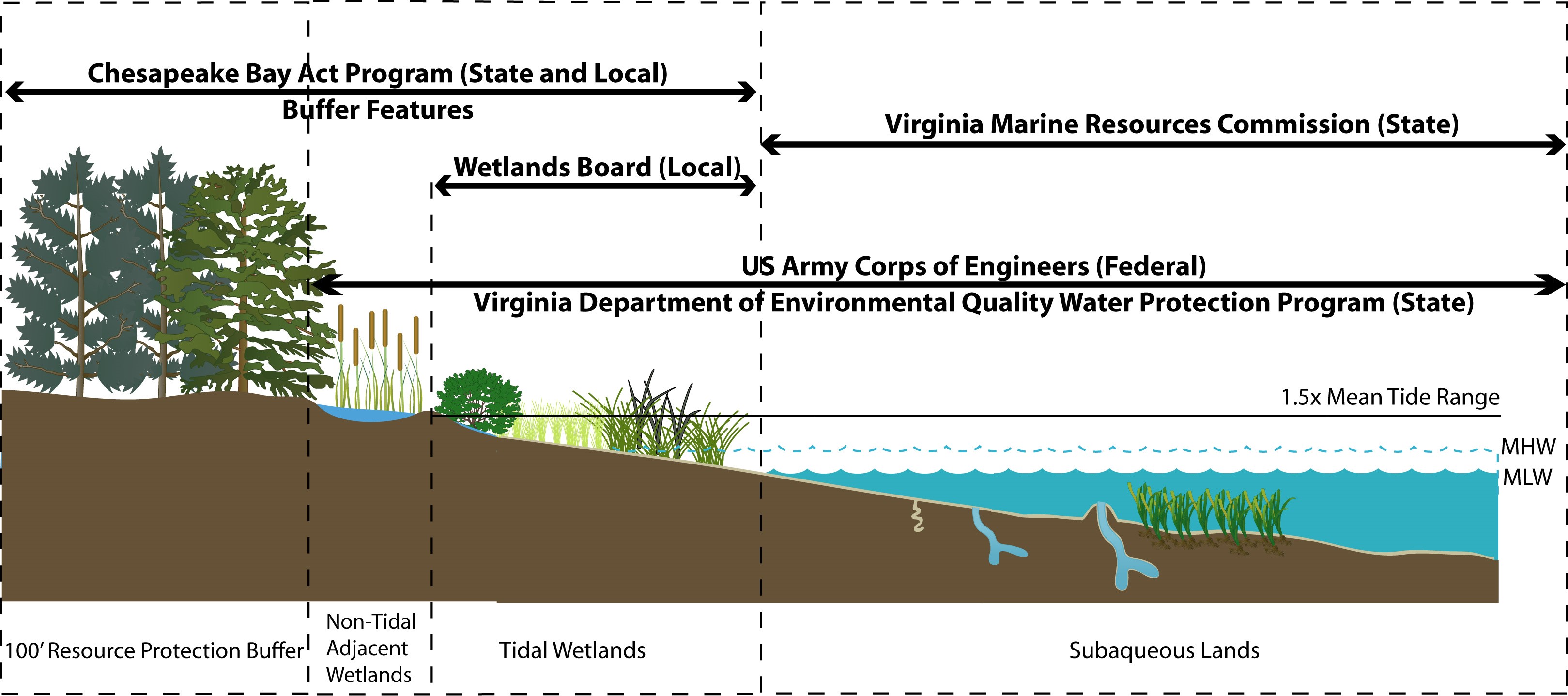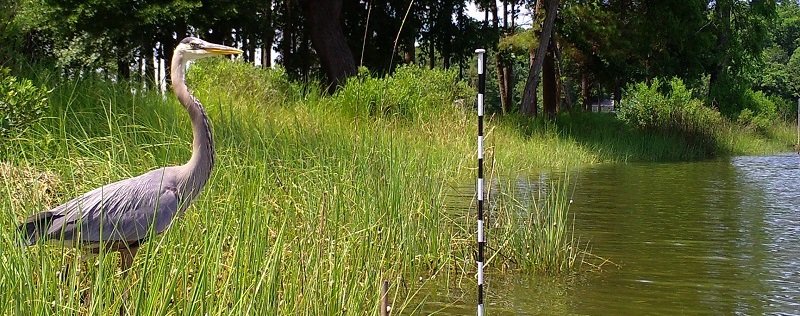I WANT TO CREATE A LIVING SHORELINE, NOW WHAT?

STEP 1 – Seek Expert Advice
Managing shoreline erosion is a complex subject. Always seek professional guidance for the design of your project. Start locally with non-profit agencies and then get a second (or third) opinion!
Understanding shared jurisdiction ...
Virginia is somewhat unique in managing tidal wetlands through a local-state cooperative program. This means that most resources have a least two responsible regulatory authorities. Each applicable agency conducts a separate and independent review and issues a permit for their jurisdiction. However all agencies share one application form - the joint permit application. The graphic below summarizes the interplay between these different programs.

|
Gathering information for your area ...
This is the perfect place to start gathering information from well-inform but objective sources, find one near you:
|
Permitting process answers ...
Next, state and local entities provide technical advice on shoreline management. Contact your local wetlands board for information on the permitting process and to request a pre-application site visit:
|
More answers to your specific questions ...
For on-site answers to your specific questions concerning your shoreline contact one of these:
|
Understanding professional help ...
You may need a shoreline professional but don't start looking yet... see STEP 2 - Choose the Right Design first, and then find a professional that specializes in the design type that you're interested in.
Consider whether to hire a professional for parts of the project, like design and permitting, or contract them to manage the whole project from start to finish.
|
STEP 2 – Choose the Right Design
When choosing a design, factors like the cause of your erosion and energy on your shoreline are important. Several site characteristics can be used to evaluate the potential success of a living shoreline.
What site characteristics do I need to consider?
Site characteristics can be used to evaluate the potential success of a living shoreline. They include:
- Fetch (or distance across open water) of 3 miles or less
- Low bank height and/or adequate area for bank grading with no strong tidal currents
- Location of shoreline in relation to winds
- Existing marsh, submerged aquatic vegetation, or trees and shrubs near the project site
- Moderate to minimal erosion and wave activity
- Shallow water depth near the shoreline
- Abundant sunlight
These characteristics are all considered in the easy to use Shoreline Decision Support Tool. |
What are the design alternatives I can choose from?
A variety of design options exist for living shorelines depending upon your site characteristics. Learn more about stabilization techniques that not only protect shorelines and infrastructure, but also help to conserve, create and restore natural shoreline habitats and ecosystem services. You will also find general design guidelines here.
|
Which plants will work for my project?
Discover the most common native plants found in each coastal habitat. These plant lists (with pictures) and other resources can help guide native plant selection for living shorelines, waterfront gardens, and habitat restoration projects.
|
What is my project going to cost?
- Construction costs for living shoreline projects and other stabilization methods vary widely depending on the shoreline length, level of protection needed, and the costs for materials and labor. Non-structural methods cost an average $50 - $100 per foot, such as beach nourishment and planted marshes. Projects with sand fill and/or stone structures typically cost $150 - $500 per foot.
- This does not include permitting costs, but if your living shoreline project meets the requirements for a General Permit, not only is the review process faster, but your application and processing fees are generally waived.
- Upfront construction and permitting costs are not the only factors to consider. The value of ecosystem services provided by living shorelines help offset these costs indirectly over time.
|
STEP 3 – Apply for the Permit, Build, and Enjoy
In general, any activity that is proposed along the shoreline, within 100 feet of the water or tidal marsh, or in the waterway, will require permits. Property owners are ultimately responsible for getting and complying with all of the necessary permits. One application is filled out and distributed to all of the appropriate agencies. If you are designing a complicated living shoreline project a consultant may be needed. Don't want to deal with the paperwork? If you hire a professional, they will complete the necessary permits for you.
Who are shoreline professionals and what do they do?
- Permit Agents – help you through the permit process. Professional services include filling out permit application documents, negotiating with regulatory agencies and adjacent property owners, and representing the property owner during public hearings.
- Marine Contractors – build and repair structures located in tidal waters like fixed and floating docks, bulkheads, revetments, and living shorelines.
- Certified Arborists – skilled tree care professionals who provide advice and expert services about tree health, pruning, tree life expectancy, and determining if shoreline trees are at risk of falling
- Chesapeake Bay Landscape Professionals – landscape designers and horticulturists who design, install and maintain sustainable landscape practices in the Chesapeake Bay region, like rain gardens, native plant gardens and living shorelines.
|
How do I find a shoreline professional?
We've provided a list of sources below, but don't forget to ask for references!
- CCRM maintains a shoreline permit database for information collected from shoreline permit applications. Upon request, CCRM will provide a list of marine contractors working in your locality (without any endorsement). Contact [[v|christine,Christine Tombleson]] / 804-684-7912 for more information.
- Find a Chesapeake Bay Landscape Professional (CBLP) – Filter the directory by "living shorelines" to find certified professionals.
- Living Shorelines Contractors List – The Chesapeake Bay Foundation maintains a list of professionals for hire who can assist you with living shoreline projects, including a contractor (to help you build), an agent (to help you through the process and permitting), and others who can help you design your living shoreline.
- Find a Certified Arborist – review terms of use then click Accept to search directory by location
- Ask a shoreline property owner that has a living shoreline approach you are interested in who they used as a contractor.
|
Tips on choosing the right professional for the job.
- If your project involves any tree removal or planting, tidal marsh creation, or native plant gardens, then you should consult with certified arborists and Chesapeake Bay landscape professionals.
- Contact more than one shoreline professional and ask them to conduct a shoreline visit to discuss your plans. Compare their answers and advice to see where they overlap or contradict.
- Seek advice from the Virginia Shoreline Erosion Advisory Service. They can assist you with plan reviews, construction inspections, and give advice about working with shoreline professionals.
|
How do I fill out a joint permit application?
The application form appears long and complicated. However, the information is critical to a well-informed decision about protected resources and not all of the pages are needed for an application. A detailed breakdown of the types of permits and help to complete an application is provided on the Permit Information page. Or, you can hire a Permit Agent to assist you (described above) |
How do I know if this is a DIY?
Fixing shoreline erosion can be easy or complicated depending on the circumstances. Quick fixes often do not work without knowing what’s causing the erosion. Seek expert advice from multiple sources about what you plan to do first. |
When is the best time to construct a living shoreline?
Projects that include tidal marshes are most successful when the new marsh is planted in spring or early summer. Trees and shrubs are best planted on the upland bank next to the shoreline in early fall. |
How long will this take?
The time it takes for the design-permitting-construction process for a living shoreline varies widely and most shoreline stabilization projects take time. It depends on what kind of project it is and how much shoreline length is involved. Allow at least 3-6 months to consult with experts and come up with a concept design, plus another 1-3 months for the permitting process at least. The construction sequence may be determined by the time of year. |
Where can I find detailed design guidance?
The Living Shoreline Technical Design Guidelines provide more detailed information and technical guidance for living shorelines in Virginia. |
Are there sources of funding assistance?
These programs will help homeowners pay for a living shoreline:
- Virginia Conservation Assistance Program (VCAP) – Reimburses 75 percent of total costs with a maximum payment of $15,000 per parcel per year for living shorelines to certain property owners within the Chesapeake Bay watershed. Financial assistance is only available to those who live within a Soil and Water Conservation District (SWCD).
- Elizabeth River Project – Reimburses 50 percent of cost up to $4,000 for a living shoreline or up to $1,500 for a shoreline buffer for waterfront River Star Homes in Chesapeake, Norfolk, Portsmouth, and the Eastern Branch area of Virginia Beach.
These programs will help homeowners finance a living shoreline:
- Middle Peninsula PDC Living Shoreline Incentive Program – Offers low-interest loans to assist homeowners with the cost of installing living shorelines on suitable properties. Loans up to $10,000 can be financed for up to 5 years. Loans over $10,000 can be financed for up to 10 years.
-
James River Association – Offers free site visit, project design, assistance with permitting process, at least 50% of construction costs, and 3 years of maintenance for homeowners with shoreline erosion who agree to maintain the living shoreline for 10 years.
|
|





